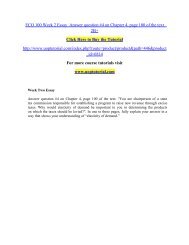ECET 370 Week 2 Lab 2
You also want an ePaper? Increase the reach of your titles
YUMPU automatically turns print PDFs into web optimized ePapers that Google loves.
<strong>ECET</strong> <strong>370</strong> <strong>Week</strong> 2 <strong>Lab</strong> 2<br />
Click Here to Buy the Tutorial<br />
http://www.uoptutorial.com/index.php?route=product/product&path=614&product<br />
_id=9328<br />
For more course tutorials visit<br />
www.uoptutorial.com<br />
General Instructions<br />
Exercises 1, 2, and 3 use the programs in DocSharinglabeled “User-defined array list."<br />
Exercise 4 uses the programs in DocSharinglabeled “Using java.util.ArrayList."<br />
Exercise 1: Review of array-based lists Create a project using the classes in the DocSharing area<br />
labeled “User-defined array list." Compile it, run it, and review the code that is given carefully.<br />
This code tests the ArrayList class provided in the lecture.<br />
Exercise 2: A user-defined array list Modify the class ArrayList given in the lecture by adding to<br />
it the functions listed below for Exercise 2. In each case, the appropriate error message should be<br />
generated if an invalid condition occurs. For example, an error message should be generated<br />
when trying to insert an item in a given location in the list and the location is out of range. a.<br />
ArrayList(int size): create a constructor that sets the size of the array list to the value passed in<br />
size (note that the class variable SIZE cannot be final anymore). b. int length(): create this<br />
function to determine the number of items in the list (accessor function). c. intgetSize(): create<br />
this function to determine the size of the list (accessor function). d. void clear(): create this<br />
function to remove all of the items from the list. After this operation, the length of the list is zero.<br />
e. void replace(int location, int item): create this function to replace the item in the list at the<br />
position specified by location. The item should be replaced with item. f. void insert(int location,<br />
int item): create this function to add an item to the list at the position specified by location. g.<br />
void remove(int item): create this function to delete an item from the list. All occurrences of item<br />
in the list should be removed. h. int get(int location): create a function that returns the element at<br />
location. i. public ArrayList copy(): create a function that makes a deep copy to another<br />
ArrayList object.<br />
Exercise 3: Using an array-based list Using the class ArrayList completed in the previous<br />
exercise, write a program that uses it to store 100 random numbers. Consider that each of these<br />
random numbers is an integer in the interval [0, 200]. Write the program in such a way that there<br />
are no number duplicates.
Exercise 4: Review of the library class java.util.ArrayList Create a project using the classes in<br />
the DocSharing area labeled “Using java.util.ArrayList." Compile it, run it, and review the code<br />
that is given carefully. This code is the complete program given in our lecture that tests the<br />
library class java.util.ArrayList.<br />
Exercise 5: Using the library class java.util.ArrayList Rewrite Exercise 3 (above) using the class<br />
java.util.ArrayList to store the 100 random numbers.













